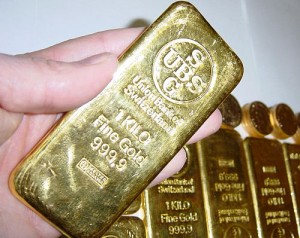This summer, a quiet change was made to the accounting rules for gold in bank vaults. It made headlines almost nowhere, but it has the potential to dramatically change how gold is viewed relative to cash in the broader economy. For informed and prepared minds, it’s also the chance to stock up up on gold at an attractive price before the mainstream masses really process the change.
 Basically, for banks, gold is now 100 percent money.
Basically, for banks, gold is now 100 percent money.
How is that different than it was before? Previously, banks could only count gold as 50 percent money.
Confused? Well, welcome to the wonderful world of bank reserve accounting. This is the system that allows banks to have $1 in actual cash but make $5, $10, or even $20 in loans on that same dollar. Reading the fine print of the regulations around this system is better than NyQuil on a late night.
But the fine print has a wealth of gems for informed minds that care about the factors influencing the value of the money supply. Under the former rules of banking reserves, cash, U.S. Treasuries, and bonds of certain other developed nations were counted as 100 percent assets, since they were perceived to be “zero risk” assets by banking regulators. Gold, on the other hand, was counted as a 50 percent asset, since gold was perceived to be a riskier asset to hold by the regulators.
Obviously, this system provided incentives for banks to hold cash and bonds instead of gold, because they could account for the whole value of the cash and bonds on their books, but only half of the value of their gold. The rules didn’t account for the falling value of the U.S. dollar or gold’s power to hedge against inflation of the money supply. Bankers had to make their own choices, but playing by the system’s rules was encouraged.
New book reveals gold-buying secrets that dealers don’t want you to know about…
And then there was this memo from the U.S. Federal Reserve, FDIC, and Treasury Department…
“In this NPR [notices of proposed rulemaking], the agencies propose to apply the following risk weights for exposures… 1) A zero percent risk weight to cash owned and held in all of a banking organization’s offices or in transit; gold bullion held in the banking organization’s own vaults, or held in another depository institution’s vaults on an allocated basis…”
No rationale was given for the change of heart, but as of January 2013 when the proposed new rules go into effect, bankers will have the choice to put their reserves into gold without having to discount their holdings.
It’s an interesting change for banks. Currently, they’re encouraged to load up on bonds and paper money, but why pile into government bonds of the dozens of developed economies on the verge of default when there’s another option out there? Gold is as sound as ever.
Whether you trust them or think they’re a pack of crooks, bankers aren’t universally stupid. They can see this is a new opportunity for their institutions to stock up on an asset class that Congress can’t create out of thin air and the European Union can’t print on demand. As a result, industry analysts are expecting that once the new risk weighting rules take effect in January, bankers are going to aggressively add gold to their balance sheets as a reserve asset.
They won’t be adding gold stocks or gold ETF holdings, either. The risk weighting rules only apply to physical gold held in the banks own vaults. The same principle of taking physical possession encouraged by smart bullion dealers everywhere is being coded right into the laws for bankers.
What does this mean for regular people? Well, for individuals, the time between now and January represents a buying opportunity. The price of gold has been holding steady at around $1,600 per ounce for several months, down from its highs near $2,000 per ounce. However, if bankers start buying and taking physical delivery of gold in bulk, the price will rise in the face of all the increased demand. So the current price of $1,600 per ounce, though definitely more than pocket change for most people, might well become the steal of the decade on gold.
©2012 Off the Grid News
 Off The Grid News Better Ideas For Off The Grid Living
Off The Grid News Better Ideas For Off The Grid Living




